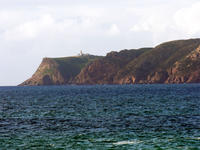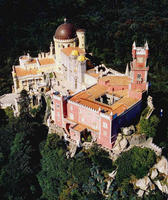You are in: Europe -> Portugal -> Cultural Landscape o... , and traditional search or Image Gallery will yield results of this site only
Cultural Landscape of Sintra
| Site number: | 723 |
|
| Type of site: | Cultural | |
| Date: | 19th century | |
| Date of Inscription: | 1995 | |
| Location: | Europe, Portugal, Sintra/Serra | |
Up to 75 images are shown here. Click on each for more details or on Image Gallery for more images.
| Description: | Sintra became the first centre of European Romantic architecture in the 19th century. Ferdinand II converted a ruined monastery into a castle where this new understanding was demonstrated in the use of Gothic, Egyptian, Moorish and Renaissance features as well as in the formation of a park combining local and exotic tree species. Other fine abodes, erected along the same lines in the adjacent serra, shaped a matchless combination of parks and gardens which further influenced the development of European landscape architecture. --WHMNet paraphrase from the description at WHC Site, where additional information is available. | |
| Sintra is both a town and a municipality in Portugal, located in the district of Lisbon. The town is a UNESCO World Heritage Site on account of its 19th century Romantic architecture. Sintra has become a major tourist attraction, with many day-trippers visiting from nearby Lisbon. Attractions include the fabulous Pena Palace (19th c.) and the Castelo dos Mouros (reconstructed 19th c.) with a breath-taking view of the Sintra-Cascais Natural Park, and the summer residence of the kings of Portugal Palácio Nacional de Sintra (largely 15th/16th c.), in the town itself. The Sintra Mountain Range, one of the largest parks in the Lisbon area, (Serra de Sintra) is also a major tourist attraction. The town was already described in the 11th century by the Arab geographer Al-Bacr and later by the poets Luís de Camões and Lord Byron (Childe Harold's Pilgrimage - 1809). The Moors built the Castelo dos Mouros in the 8th or 9th century. When Afonso Henriques, with the aid of Crusaders, recaptured Sintra in 1147, much of the castle was destroyed. Only four square towers, the battlements, and the ruins of a Romanesque chapel survived. In 1493, Christopher Columbus sailing for the Spanish crown, was blown off course by gale force winds and fearing for the survival of his ship, spotted the Rock of Sintra. Despite the awkwardness of seeking safe harbor in Portugal, Columbus had no choice under the circumstances and sailed from there into the Port of Lisbon. In 1507, Diogo Boitac built the Hieronymite monastery of Nossa Senhora da Pena on the nearby hilltop. In 1527 king Manuel I commissioned to Nicolau Chanterene the large, white marble and alabaster altarpiece for the chapel. This retable is his finest work. In 1808, it was the site of the signing of the controversial Convention of Sintra, which ended the first French invasion of Portugal. --Wikipedia. Text is available under the Creative Commons Attribution-ShareAlike License. | ||
| Source: | http://whc.unesco.org/en/list/723 | |
| Reference: | 1. UNESCO World Heritage Center, Site Page. | |











































